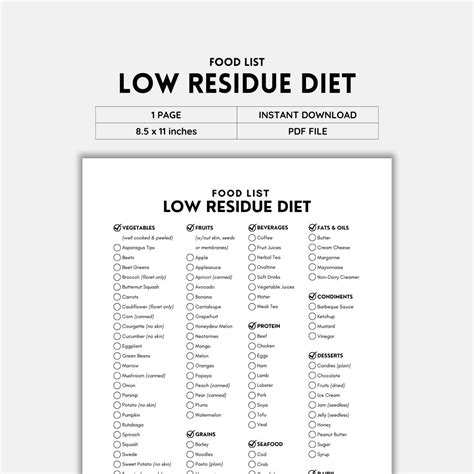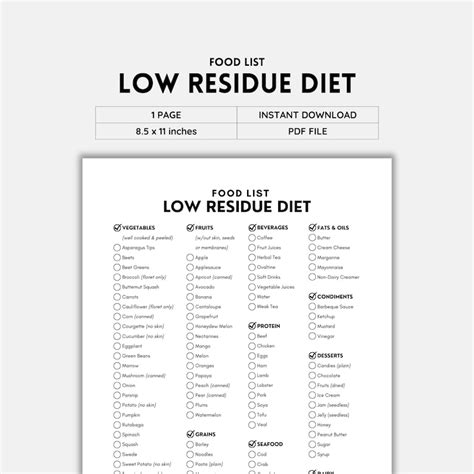Intro
Discover the ultimate Low Residue Foods List, featuring gentle gut-friendly options like bananas, rice, and applesauce, to help manage digestive issues and promote healing with low-fiber, easily digestible foods.
The concept of low residue foods is crucial for individuals who require a diet that is easy to digest, particularly those with gastrointestinal issues or undergoing certain medical treatments. A low residue diet, also known as a low fiber diet, is designed to reduce the amount of undigested food that reaches the colon, thereby minimizing the risk of complications in the digestive system. This type of diet is often recommended for patients who have undergone bowel surgery, have inflammatory bowel disease, or are experiencing acute gastrointestinal symptoms.
The importance of understanding and adhering to a low residue diet cannot be overstated, as it can significantly impact the management of symptoms and the healing process. Foods that are high in fiber, seeds, nuts, and certain fruits and vegetables can be challenging for the body to digest and may exacerbate gastrointestinal issues. By focusing on low residue foods, individuals can help ensure a smoother recovery and reduce the risk of complications.
For those who are new to the concept of low residue diets, it can be overwhelming to determine which foods are safe to eat and which should be avoided. The key is to focus on foods that are low in fiber, easy to digest, and rich in essential nutrients. This includes a variety of foods such as lean proteins, low-fiber fruits and vegetables, dairy products, and whole grains that are low in fiber. By making informed choices about the foods they eat, individuals can better manage their condition and improve their overall quality of life.
Introduction to Low Residue Foods

A low residue diet typically includes foods that are low in fiber, such as bananas, rice, applesauce, and toast, often referred to as the BRAT diet. These foods are easy to digest and can help minimize the risk of gastrointestinal complications. It is essential to note that a low residue diet should be tailored to an individual's specific needs and health status, and it is crucial to consult with a healthcare provider or registered dietitian to determine the best course of action.
In addition to the BRAT diet, there are many other low residue foods that can be incorporated into a healthy and balanced diet. These include lean proteins such as chicken, fish, and eggs, as well as low-fiber fruits and vegetables like avocados, cucumbers, and bell peppers. Dairy products like milk, cheese, and yogurt are also low in fiber and can provide essential nutrients like calcium and protein.
Benefits of Low Residue Foods
The benefits of a low residue diet are numerous, particularly for individuals with gastrointestinal issues. By reducing the amount of undigested food that reaches the colon, a low residue diet can help minimize the risk of complications such as bowel obstruction, diarrhea, and abdominal pain. Additionally, a low residue diet can help reduce inflammation in the digestive system, promote healing, and improve overall nutrition.Some of the key benefits of low residue foods include:
- Reduced risk of gastrointestinal complications
- Minimized inflammation in the digestive system
- Promoted healing and recovery
- Improved nutrition and overall health
- Enhanced digestive comfort and reduced symptoms
Low Residue Foods List

The following is a comprehensive list of low residue foods that can be incorporated into a healthy and balanced diet:
- Lean proteins: chicken, fish, eggs, turkey
- Low-fiber fruits: bananas, avocados, cantaloupe, honeydew
- Low-fiber vegetables: cucumbers, bell peppers, carrots, green beans
- Dairy products: milk, cheese, yogurt, ice cream
- Whole grains: white bread, white rice, plain crackers, pasta
- Snacks: pretzels, plain cookies, popsicles, gelatin
It is essential to note that everyone's nutritional needs and health status are different, and it is crucial to consult with a healthcare provider or registered dietitian to determine the best course of action. Additionally, it is essential to avoid foods that are high in fiber, seeds, nuts, and certain fruits and vegetables, as they can exacerbate gastrointestinal issues.
Foods to Avoid on a Low Residue Diet
Foods that are high in fiber, seeds, nuts, and certain fruits and vegetables should be avoided on a low residue diet. These foods can be challenging for the body to digest and may exacerbate gastrointestinal issues. Some examples of foods to avoid include: * High-fiber fruits: berries, citrus fruits, apples, pears * High-fiber vegetables: broccoli, cauliflower, Brussels sprouts, cabbage * Nuts and seeds: almonds, walnuts, chia seeds, flaxseeds * Whole grains: brown rice, quinoa, whole wheat bread, whole grain pasta * Legumes: beans, lentils, peas, soybeansManaging a Low Residue Diet

Managing a low residue diet requires careful planning and attention to detail. It is essential to read food labels, avoid high-fiber foods, and incorporate low residue foods into your diet. Additionally, it is crucial to stay hydrated by drinking plenty of water and other low-fiber fluids.
Some tips for managing a low residue diet include:
- Eating small, frequent meals to reduce digestive discomfort
- Avoiding foods that are high in fat, salt, and sugar
- Incorporating low residue foods into your diet, such as bananas, rice, applesauce, and toast
- Staying hydrated by drinking plenty of water and other low-fiber fluids
- Consulting with a healthcare provider or registered dietitian to determine the best course of action
Common Mistakes to Avoid
When following a low residue diet, there are several common mistakes to avoid. These include: * Not reading food labels carefully * Eating high-fiber foods without realizing it * Not staying hydrated * Not incorporating enough low residue foods into your diet * Not consulting with a healthcare provider or registered dietitianBy avoiding these common mistakes, individuals can help ensure a smooth and successful transition to a low residue diet.
Conclusion and Next Steps

In conclusion, a low residue diet can be an effective way to manage gastrointestinal issues and promote healing. By understanding which foods are low in fiber and easy to digest, individuals can make informed choices about their diet and reduce the risk of complications. It is essential to consult with a healthcare provider or registered dietitian to determine the best course of action and to ensure a smooth and successful transition to a low residue diet.
We invite you to share your experiences and tips for managing a low residue diet in the comments below. Additionally, if you have any questions or concerns, please do not hesitate to reach out. By working together, we can help promote digestive health and well-being.
Additional Resources

For more information on low residue diets and digestive health, please visit our website or consult with a healthcare provider or registered dietitian. We have a wealth of resources available, including articles, videos, and recipes, to help you manage your condition and promote overall health and well-being.
What is a low residue diet?
+A low residue diet is a type of diet that is designed to reduce the amount of undigested food that reaches the colon, thereby minimizing the risk of complications in the digestive system.
What are some examples of low residue foods?
+Some examples of low residue foods include bananas, rice, applesauce, toast, lean proteins, low-fiber fruits and vegetables, dairy products, and whole grains that are low in fiber.
How long do I need to follow a low residue diet?
+The length of time you need to follow a low residue diet will depend on your individual needs and health status. It is essential to consult with a healthcare provider or registered dietitian to determine the best course of action.
